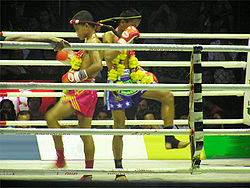Muay Thai or thai boxing is an ancient combat sport that is practiced in Thailand and is very popular. Today, Muay Thai descends indirectly from the armed combat sport Krabi Krabong. When a Krabi Krabong fighter was no longer in possession of his arms, he was able to use his body parts as lethal weapons. This style is called Muay Boran. The competition oriented Muay Thai stems from the lethal Muay Boran (ancient boxing).

However, thai boxing - in which everything seems to be allowed at first sight - is confided to rules. Permitted is the use of fists, elbows, knees and legs. The technique of the use of fists is almost equal to boxing. The difference sits in the use of knees, elbows and legs. However, many of the old Muay Boran techniques are no longer allowed because they are simply too lethal.
Muay Thai uses weight classes to divide thai boxers. At competitions, two people from the same weight class fight each other. The highest class has no upper limit and is called super heavyweigth. Boxers can never enter a weight class of which the maximum weight is smaller than the boxer's weight. However, they can always enter a higher weight class. Professional boxing knows the following weight classes:
| weight class | up to (kg) |
|---|---|
| super heavyweight | - |
| heavyweight | 99,79 |
| cruiserweight | 86,18 |
| light heavyweight | 79,38 |
| super middleweight | 76,20 |
| middleweight | 72,57 |
| super welterweight | 69,85 |
| welterweight | 66,68 |
| super lightweight | 63,50 |
| lightweight | 61,23 |
| super featherweight | 58,97 |
| featherweight | 57,15 |
| super bantamweight | 55,34 |
| bantamweight | 53,52 |
| super flyweight | 52,16 |
| flyweight | 50,80 |
| light flyweight | 48,99 |
Input
One single line with the weight $$g \in \mathbb{R}$$ of a professional boxer (in kg).
Output
One single line with the text Weight class: followed by a space and the English name of the lowest weight class in which a boxer can participate.
Example
Input:
57.23Output:
Weight class: super featherweightExample
Input:
72.53Output:
Weight class: middleweight